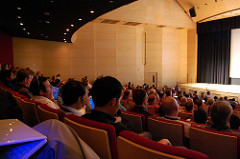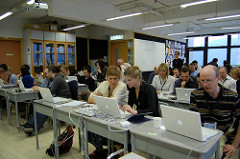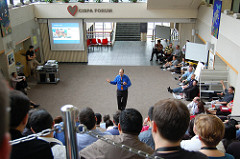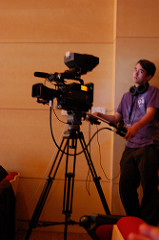The Next Generation Conference by Kim Cofino

Cross-posted on Always Learning
I've been to a lot ofconferences this year. So, I've been doing a lot of thinking about conferences, mostly about how to make them a better experience for the participants. After the absolutely fantastic Apple Global Leadership Summit in Hong Kong last week, I had a bit of a brainwave. Here's how I think a really engaging, exciting, and community-building conference could be run (apologies if there's already conferences out there like this, I just haven't been to any):
Action
So many conferences follow the "sit 'n git" model where participants sit in room after room (or if you're incredibly unlucky, the same room all day) listening to "experts" tell you how things "should" be done.
There's no time in the schedule for actually doing something with our new knowledge, and sadly, often no time for just talking and interacting with our fellow conference goers in a learning- or topic-focused environment (coffee breaks don't count).
We need to make conferences more practical, not just hands on training with new tools, but a focus on the actual creation of something that bridges new learning with what you already know, and asks you to create something useful.
Although it was great to see so many hands on sessions at the Hong Kong summit, as a presenter, it seemed like the hands on training felt very isolated to the new content presented and there really wasn't enough time (1 hour for a hands on session) to activate and engage participants' prior knowledge within the workshop as a whole.
Tools and ideas to transform education. Sign up below.
As the ADE Institute and the Flat Classroom Conference did very well, conferences should make the event about some sort of action or project that bridges the theory, content and tools, helps build your network, and requires you to leave with something tangible.
Grouping/Differentiation
I would love to see a conference where attendees were grouped the first day (by choice, ability, experience or interest, organized in advance with color-coded nametags), and spent the whole conference reconnecting in various formats with a group leader (during an Apple conference, this could be an ADE group leader) to create something together.

All groups could have an ongoing task that lead you through the conference, asking participants to put their new knowledge to work, building on each plenary and presentation session, and then culminating in the production of something practical and useful during a hands on workshop time. The hands on workshop time could be lead by the same group leader, and introduce group members to the all of the different tools they will need to create their final action project (from a presenter's perspective, this could be the new role of the "presenter" or "ADE Workshop Leader" at a conference).
Between keynote sessions, these groups could come back together to digest and discuss the information presented and then begin to develop an action project that utilizes this new knowledge. If the groups regularly meet in the same classroom over the course of the conference materials could be kept & posted around the room. In order to ensure that there was enough cross-pollination across all conference attendees, the group action projects could be structured in such a way that each group is required to interact with members from the other groups in order to complete their project.

In terms of practicalities, in a conference of around 500 people, you could create 17 groups of 30 people, or 20 groups of 25 people (that raises your number of "presenters", and therefore the cost of travel and hotel, but it would be so worth it for everyone). Group leaders could have a meeting before the conference starts to discuss, plan, and network among themselves. (And by the way, why don't we have sessions for the presenters to network at conferences either? They miss out on all the casual conversations because they're so busy organizing and prepping for their own presentations!)
DiversityWhy, oh why do we still see the same presenters at every conference? I don't mean the same individual people (although that can be a problem too). I mean the same older, white, males. Where's the diversity? Gender, race, age, experience? How did we get trapped in this model where we think only older white men have something to offer?

There have been many posts about the need for diversity in conference speakers, but some things never seem to change. This needs to make it to the top of the list for conference organizers.
We need speakers that represent our society. It's not a planet full of older, white, men, but our conferences make it seem that way.

Students
Along the lines of diversifying presenters, why is it that we have all these conferences about learning and how to meet our students needs, but we never actually have any student participants or presenters? I'm not talking about handing out badges or directing people to the right room, I mean students leading sessions. Maybe sessions on how to use new tools or on what they're doing with technology outside of school, or what they'd like to see in school (imagine that?). What about having students as experts on a panel discussion of what schools should be doing with technology? Or how technology has changed the way they receive, create and distribute information?
Time for Reflection
As much as I loved the Hong Kong Summit, there was simply not enough time for reflection and metacognition. No matter how much you know about a topic, there is always a need for discussion after an engaging session. After each session, a group leader could facilitate an unconference style discussion, with a focus question or Visible Thinking routine to get people processing the information. If participants are working within the groups outlined in the first paragraph, they would get to know each other well during these breakout unconference sessions, and knowledge could be built as a collaborative team towards the final action project.
Dialogue

Here's one of the many things I have learned from the past two years working in the elementary division. Every single presentation must include room for dialogue, not always with the presenter but just with the people you're sitting next to, even keynotes. Just a simple opportunity to chat with the person you've never met (but had to crawl over to get to the only remaining seat in the middle of the row) based on the information you're learning. We know we have to do this in the classroom, and the same applies in a conference - it's just a big classroom, right?
Movement
Do not sit in the same room all day no matter how logistically convenient it is.
Final Thoughts
What have I missed? What would you like to see in a next generation conference format?
World Mosaic: A Tribute to Flickr Portraits by pardeshi
